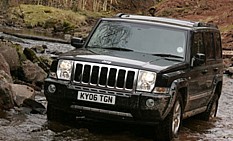Review
So by introducing what can only be described as a 'soft-roader' as a replacement for the original 'off-roader' the question is - has Jeep gone soft?
There is little doubt that the old Cherokee was the 'daddy' of modern 4x4s with its rough and rugged styling winning the hearts and minds of drivers for many years. Where the old model was angular and square-jawed the new Cherokee's lines are soft and flowing.
It even has round, bulbous front lamps that give it a startled-rabbit-in-the-headlights look. In fact, the only family resemblance is the familiar seven-slot front grill and, of course, outstanding off-road performance.
The new Jeep Cherokee makes scrambling down a gruelling boulder course feel like you've just popped out to the shops to buy some milk. Fighting your way over rugged terrain and through water seems like no more hassle than dropping the kids off at school.
The new Cherokee makes off-roading seem like nothing more than mounting the kerb. But the sad thing is that mounting the kerb is about as much off-roading as this car will do in its working life.
So urban 4x4 drivers rejoice - for your convenience the new Cherokee is fitted with a bundle of extras to make your life easier. For example, the boot can now be opened from a button on the key fob. So when you've got your hands full of shopping bags just click the button and the boot will open. And then there's the increased boot space achieved by mounting the spare wheel to the rear door.
There's even a shopping bag holder on the back of the rear seats. But wasn't the original Cherokee supposed to be an off-roader rather than a soft-roader?
'Marketeer-speak' will tell you that Jeep has simply made the new Cherokee more appealing and more flexibly engineered for both on- and off-road performance and offers a combination of ruggedness and refinement.
But from a fleet point of view, the fact that the 3.7-litre V-6 engine offers a combined fuel economy figure of 19.3mpg and emits 347g/km of carbon dioxide might be a little worrying. This puts the new model straight into the 35% tax band under the new CO2-based tax regime.
The 2.5-litre common rail diesel engine returns 31.4mpg and has a CO2 rating of 250g/km. Because the engine does not meet Euro IV emission standards it incurs a 3% penalty, which means that it also qualifies for a benefit charge of 35% of the vehicle's list price.
Much of the emphasis inside the new Cherokee is on comfort. Plush seats give a commanding view of the road while the all-new independent front suspension offers a soft ride. The new Cherokee is tall and there is a noticeable amount of body roll in corners. Bigger tyres disguise the ups and downs of the road, making the steering irritatingly vague. In fact it was dead to the touch for most of the journey.
But take the new model off-road and things liven up. The steering comes in to its own and copes well with the terrain while the state-of-the-art suspension means that the ride quality is maintained. But drivers will find those made-for-city seats fail to provide support when venturing away from the suburban jungle.
The new design means there is plenty of head and legroom in the front. Even in the back there is more room than in the old Cherokee, but things are still cramped.The layout of the dash is clear and easy to read. But the cabin is let down by its overly eager use of bland, uninspiring plastics.
Jeep's battle plan is to offer a better spec car for less money than its key competitors, offering instead a credible alternative. Competitive pricing means that the new Cherokee will go head to head with the Land Rover Freelander.
The 2.4-litre Sport costs £17,995, 5% lower than the Land Rover Freelander 1.8S. The Jeep Cherokee 2.5-litre CRD Sport is the same engine already used in the Chrysler Voyager and in this Jeep guise is £20,195. Compared to the Freelander TD4 GS its price is 1% cheaper.
The new Cherokee also has an impressive list of standard equipment on the entry level Sport trim including ABS, driver and passenger airbags, 16 in alloy wheels (not on 2.4 Sport), electric heated door mirrors, air conditioning, electric rear windows, single CD/radio/cassette player.
For the best part of the test route I drove the 2.5CRD manual, which seems to have been designed for off-roading. Its powerplant delivers 143bhp and offers drivers plenty of low-end torque. But it does not provide quick acceleration. Perhaps this is due to the fact that the 3.7 V6 weighs in at 1,847kg while the 2.5CRD has a kerb weight of 1,891kg.
This is more than the Nissan X-Trail 2.0-litre, which weighs 1,466kg or the 2.2 diesel with a kerb weight of 1,541kg.
The Jeep diesel has a manual gearbox that can at times seem like a lot of hard work. By the time I'd finished, I swear my left leg was bigger than my right.
The new Cherokee's diesel powerplant is more suited to off-road than on-road driving. The 2.5CRD offers 143bhp but with such a heavy vehicle on-road performance and acceleration is hampered.
That said, the new model is capable but not outstanding in the city and on the motorway. Only when taken off-road does the car show its true colours and allow low-end torque to shine through.
While it may look soft, underneath it is all Jeep.













Login to comment
Comments
No comments have been made yet.